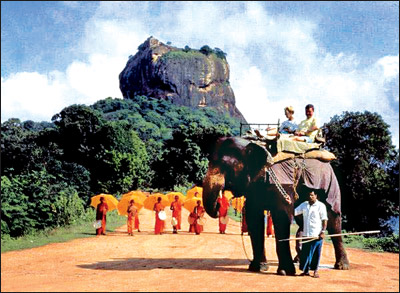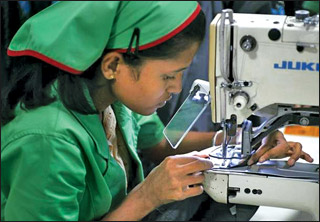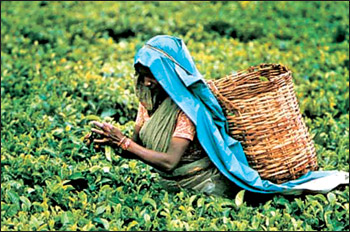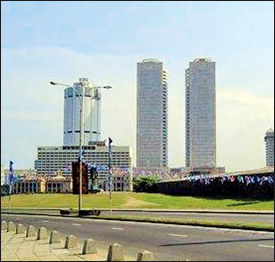Lanka an Economic Tiger in the making
Rohantha Athukorala
As we celebrate the first year of eradicating the LTTE, I will never
forget the experience I had in the North of Sri Lanka when I was heading
Economic Affairs for the Government Peace Secretariat exactly a year
ago. The final battle was in full operation at that time and after
finishing my assigned tasks in Jaffna, I was en-route to Colombo on the
C130 military aircraft and we had to make a stop in Anuradhapura to pick
seriously injured soldiers from Puthumathalan on that day.
|

“Sri Lanka - the Miracle of Asia” |
Even though it was mentally tough to see the seriously injured
soldiers brought straight from the battlefield, when I spoke to them I
was amazed at the dedication and commitment demonstrated. One soldier
with a severe chest injury told me ‘Sir I am going to come back and
finish the LTTE’.
Being part of the public sector at that time, I realized that it is
time that the other half of the public sector, now shoulder this same
responsibility and re-build the economy and one side has done its task
even at the expense of losing their lives. I guess the time is right for
us to evaluate what we have achieved in the last year.
Visionary community
While there has been many a development in the political arena in the
last one year, to my mind the last year was spent on building a
visionary community. After the Presidential election we saw how film
stars, sportsmen, businessmen and many young professionals wanting to be
part of governing the country. To my mind this infusion of young blood
into the system is an indication that we are in the process of being an
economic tiger in Asia.
I also believe that the general mass has also accepted the common
vision and voted in a set of leaders who now almost make up a two thirds
majority, thus, giving the ability to initiate serious policy reforms.
The key question now is will those hard decisions be taken this year
so that the benefits can come to Sri Lanka by 2011.
A point that needs to be noted is that I see that the private sector
has also become positive to the changing business environment. Gone are
the days when business plans had statements like Raging war in the North
of Sri Lanka or Political instability due to a coalition government.
Given the exit of these statements, we now have a private sector that
can also plan strategically for the future and do the internal reforms.
I guess the many hotels that are being closed in the next few months
for re-furbishment, clearly demonstrate this forward thinking
perspective.
Hard decisions
While I agree with the many sentiments expressed of Sri Lanka
becoming the miracle of Asia, I feel the need of the hour is to accept
the reality and correct it before we start chasing dreams.
The reality is that Sri Lanka was targetting at curtailing the GDP
deficit to 7 percent last year but ended the year at 9.8 percent. If we
are to drive down the expenditure and get fiscal discipline we have to
correct the many State run enterprises that were losing in 2009. Recent
data reveals that almost 1 percent of the
|

Apparel: high potential industry |
GDP or around 45 billion rupees is the opportunity cost for Sri Lanka
due to this loss making ventures. CEB is in the red at 7.4 bn, CPC is at
a staggering 12.3 bn, SLTB is at 5.1 bn in the red and SriLankan
Airlines at a crazy 12.2 bn to name a few.
Hence, the only way out is to re-structure and re-model these loss
making State ventures. It can be done just like what we saw in the case
of British Telecom, Indian Railways and Singapore Airlines to be
specific.
But it requires hard decisions which are not going to be popular
politically or by the trade unions. However, it has to be done if we are
serious about putting our economy in shape.
The best way forward is a private-public partnership approach.
However, for this to materialize, we need to make sure that the
regulatory environment is conducive. If not, just like the privatized
tea industry, we will see the private sector in a Catch 22 situation
than driving ruthlessly for value addition.
Engagement of IMF
It is important to understand that in the Sri Lankan economic menu,
we must continue the engagement with the IMF. The logic being that the
IMF helps Sri Lanka to have in its radar the importance of implementing
fiscal discipline. We have no option but the expenditure has to be
reduced significantly. The Government of the Maldives is a classic
example for us. From a 27 percent GDP deficit it has been reduced to 18
percent last year and the target set for this year is 8 percent which is
an outstanding performance.
Being part of the donor conference in the Maldives that garnered 313
million dollars as grant money into the country, President Rasheed very
proudly stated that a 20 percent salary cut was accepted by the public
sector that led the way for the curtailment of expenditure that won the
respect of the donor community including the IMF. I guess its time Sri
Lanka takes a cue from this initiative.
Slide to war
Research done globally reveals that half the countries who achieve
peace slides back to a conflict mainly due to the citizens of the
country not taking responsibility for the actions to determine their
future. Countries like Rwanda made sure it will not happen like the
issues between the Tutsis and Zulus with focused on post conflict
strategies. It is paramount that every Sri Lankan understands that
unless we each shoulder some responsibility we cannot get Sri Lanka back
into the 7 percent+ GDP growth levels.
Also we need to understand that if the country grows, then we grow
and this can lead to sustainable growth. If not peace is only an
illusion. Let me get specific again so that this article is a real piece
and not just entrepreneurial academics.
As per the labour force survey of 2002, the labour force
participation is at 50.3 percent nationally whilst in the North it had
dropped to 33.8 percent and 40.3 percent in the East. This data can
directly be reflective to the health gaps in these regions. 46 percent
of the children below five years of age in the North and the East are
underweight compared to the 29 percent of the rest of the country.
The percentage of babies born underweight in the country is 18
percent but the reality is that in the North and the East it is as high
as 26 percent. These figures are worse in the districts like Batticaloa
and Vavuniya, where one -half of the children are underweight which
gives us an insight to the tension that exists within a family in
comparison to one’s relations in the other parts of the country. I guess
post the resettlement process in the North these indicators must be at a
lower ebb and we have to address this as a priority so that the economic
disparity can be addressed.
Value addition
|

Tea: another potential industry |
The key to driving growth and increasing household income is by
driving value addition. If we examine this indicator, Sri Lanka’s
performance in 2004 is not bad in relation to similar countries in South
Asia but the fact is that we must aim to get closer to countries like
Singapore and Malaysia where only in the agricultural sector is at a
mammoth 7,108 USD per person as against Sri Lanka’s 951 USD.
We also must drive up industrial value addition from 3,187 USD to the
levels as 18,295 USD that Malaysia operates on. What’s worrying is the
declining industrial exports in 2010 and low investment on R and D of
the agricultural sector which means we are not taking the high ground to
arrest this situation.
Drive high potential industries - Apparel
Michael Porter says that the only way a country’s standard of living
can be increased is by driving up productivity with sharp, strong
strategies which will be reflective to the human capital and resources
that a country has. Hence we have no option but to prioritize the key
initiatives that Sri Lanka must focus on.
Sri Lanka’s apparel sector will have to be a key focus area to
generate a five billion dollar revenue for Sri Lanka. The apparels
sector has to move away from manufacturing garments to manufacturing
fashion clothing the ethical way. The logic being that, as per the ADB
Study on the Asian Textile and Apparel Industry it reveals that almost
68 percent of the apparel machinery imported globally, has been to Asian
countries which will infer the entrenched competition that Sri Lanka
will face in the future.
Currently Sri Lanka is feeling the heat as it is losing the top
senior level management talent to Bangladesh given the development of
its apparel sector due to the FTA with Japan. Separately the ADB study
has also revealed that Asian textile suppliers have increased the cotton
spinning output to 74.1 percent of the world requirement which means
that cut throat pricing is on the table for Sri Lanka.
Given the increased cost in the Sri Lankan model, the only way out
for Sri Lanka is to drive stronger integration with fashion designers
and use the nano technology project to achieve competitiveness through
innovative designs given that we do not have the dominance of the value
chain.
This, coupled with the ethically manufactured proposition with the
Effie Award winning Garments without Guilt campaign can reshape Sri
Lanka’s apparel business. Policy makers must now drive for the FTA with
India to work for this industry and also secure GSP+ as a priority.
Currently it has been only promises from India of an increase from three
million pieces to seven million pieces of garments to be imported into
India whilst the reality is that negligible exports are registered. Sri
Lanka must also unleash its true potential to make the Bangkok Agreement
a reality. Currently the utilization of the quotas is below 5 percent
which explains the opportunity for this industry.
Drive high potential industries - TEA
With the Sri Lanka Tea Board driving an aggressive post war marketing
strategy, I strongly feel Sri Lanka is on its way to regaining its
dominance in the world stage from Kenya on the positioning of Ceylon Tea
- Ethically manufactured ‘Clean Tea.’ We have to make this industry a
two billion dollar industry.
This can be done only if the completion of the field trials on
Minimum Residue Levels (MRL) and a new Sri Lankan standard set for our
tea so that we command the respect as a leading exporter of tea to the
world while the Geographical Indicators (GI) registration must be done
in the key markets as recommended by the Tea board.
This will give protection to the Ceylon Tea brand name which actually
should have been done fifty years ago. Sri Lanka must develop a focused
marketing program to build 10 new brands in ten countries with an
investment by the State increasing to at least five million dollars so
that with the private sector investment we can pump in a 20 million
dollars plus worth of brand marketing to the world.
The industry must push for the 1.2 billion rupees the industry
ploughs back into the Sri Lankan coffers as CESS be invested in the
industry for the development of the sector from a supply and demand
side. The overall impact these initiatives will have on the one million
people who depend on this industry for their livelihood will sure
unleash the true potential of Sri Lanka.
Drive high potential industries - Tourism
 The
new positioning that has been very well conceptualized by the Sri Lanka
tourism Ministry needs more muscle in terms of funding with a strong
private -public partnership to make the “Sri Lanka - the miracle of
Asia” work for the country. The logic being even though Sri Lanka has
registered a 50 percent + growth in the first four months and is ranked
No. 1 by the UNWTO the awareness levels of our country globally is only
3 percent and market shares are at low ebb of 0.07 percent. The need of
the hour right now is how we can have 35,000- 40,000 room capacity in
Sri Lanka to attract the 2.5 million tourists in the near future. The
current 14,700 rooms can only cater to a maximum of 760,000 visitors and
in fact 50 percent of the rooms needs upgrading. The
new positioning that has been very well conceptualized by the Sri Lanka
tourism Ministry needs more muscle in terms of funding with a strong
private -public partnership to make the “Sri Lanka - the miracle of
Asia” work for the country. The logic being even though Sri Lanka has
registered a 50 percent + growth in the first four months and is ranked
No. 1 by the UNWTO the awareness levels of our country globally is only
3 percent and market shares are at low ebb of 0.07 percent. The need of
the hour right now is how we can have 35,000- 40,000 room capacity in
Sri Lanka to attract the 2.5 million tourists in the near future. The
current 14,700 rooms can only cater to a maximum of 760,000 visitors and
in fact 50 percent of the rooms needs upgrading.
This means that we need a minimum investment of 3.5 billion dollars
to make the 2.5 million tourist arrivals a reality which is the core
task at hand. We must accelerate the development of Kuchhaveli,
Pasikudah and Kalpitiya tourist zone development projects.
A point to note is that way back in 1983 Sri Lanka attracted 338,000
tourists into the country and in 2008 is yet struggling at just 438,000
when countries like Cambodia which were getting 200,000 in 1983, are
touching almost a 2,000,000 which is the opportunity that Sri Lanka has
lost which in financial terms is worth over 6,000 billion rupees. We now
need to make this industry a one billion dollar industry for Sri Lanka
so that we can actually say that Sri Lanka is in the making to be an
economic tiger in Asia.
Importance of the North and the East
The fact is that N-E is the most under developed region in Sri Lanka.
However, the good news is that these economies continued to grow in the
last two years even after the ceasefire fell apart in 2004 with the East
growing at 2-3 percentage points faster than the national average both
in 2006 and in 2007 and contributing around 4.8-5 percent to national
output.
But a careful analysis reveals that the Agricultural sector growth in
the North and East had declined by almost a 10.3 percent in the period
2005-2007 which needs to be corrected.
The reason for this being that in the North from 56,000 MT of fish
that were caught in 2004 has dropped to 15,000 MT in 2007 while in the
East in 2002 almost 72,000 MT of fish were caught and in 2005 it dropped
to 22,380 MT. But in 2008 it has increased to 61,000 MT which means that
economic recovery is very quick in this sector and this benefit will
come to the North too.
But once again the challenge is to develop the total value chain from
cool rooms to ice plants and freezer trucks so that the total physical
distribution system is managed and may be even a fish canning factory
can be built to drive the export market.
The Atchuweli Industrial Zone must be re activated so that we can
provide employment to the 200,000 youth that Jaffna has. If Sri Lanka
does not address this issue speedily we can expect another revolt
similar to the early days of the LTTE movement, is my belief.
Peace is a process-with minority
A key element to really unearth the true potential of the country is
to create awareness that peace in a country is a process. This includes
the Language Policy, the Governance structure, the Economic Development,
the Human Rights and Democracy, IDP Resettlement and that the Military
Strategy which was used was also part of the process.
All these elements must go hand in hand so that we ensure that we
address the root cause of terrorism.
Whenever I am called to address a forum the private sector keeps
asking me how a company can contribute to peace building and the
practical step is to operationalize the language policy in a company
i.e. a telephone operator must be fluent in all three languages, all
circulars/notices must be in three languages. We have to make the
minorities feel that they are part of the country so that we really can
unleash the true potential of this country may be by attracting the
talented diaspora back into this country.
Competitiveness of SMEs
This can only be done if the State makes the necessary changes by
investing in Research and Development (R and D) and focuses on the SME
sector. The current R and D investment is estimated at below 0.2 percent
whilst we should invest at least 2.0 percent if we are to really unleash
the true potential of Sri Lanka with a culture of innovation.
A case in point where investment on R and D has worked was seen where
a red onion farmer in Kalawanchchikudy moved from manual irrigation to
drip irrigation which increased production by 3,200 MT from an
investment of just Rs 50,000. This kind of competitiveness moves is what
Sri Lanka requires.
The current Gemidiriya project of empowering the youth is a project
that must get more muscle from the policymakers is my view as it is
changing the lives of rural households effectively. Maybe Sri Lanka can
develop a dedicated Nano Technology Park so that we become a nation that
drives the South Asian economy with innovation.
Nation Branding-all Ministries
If Sri Lanka can implement the concept of nation branding the
synergistic effect can even match the fat advertising budgets of any
country that will not only help Tourism but Ceylon Tea, Cinnamon and all
exports of Sri Lanka. Turkey is the best country to explain this concept
where even though in Turkey there is a terrorist group called the PKK it
practises nation branding effectively that has resulted in attracting
almost a two million visitors.
The best case in point is Turkey, in the German market exposed the
people to Turkish cuisine on the streets, Turkish politicians are
featured on German media, sports personalities of Turkish origin are
interviewed on TV and if a German visits a department store one gets
exposed to products made in Turkey. This together with the marketing
spend by the Turkish Tourism Ministry creates a synergistic effect that
results in the record numbers of visitors coming in from Germany that
was more than one million in number. Sri Lanka can test it out in a
country in the Middle East and thereafter roll it out globally in the
future.
Conclusion
The only words that now echo in my mind are the words expressed by my
friend Mohamed Ali Alabbar the Director General of he Dubai Economic
Centre, he said “The difference between success and failure often lies
not in the strength of the vision or the effectiveness of the strategy
but in the ability of the leader to execute”. |



